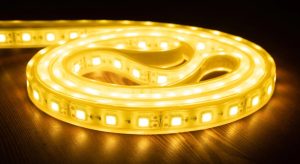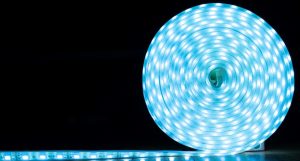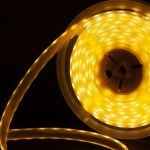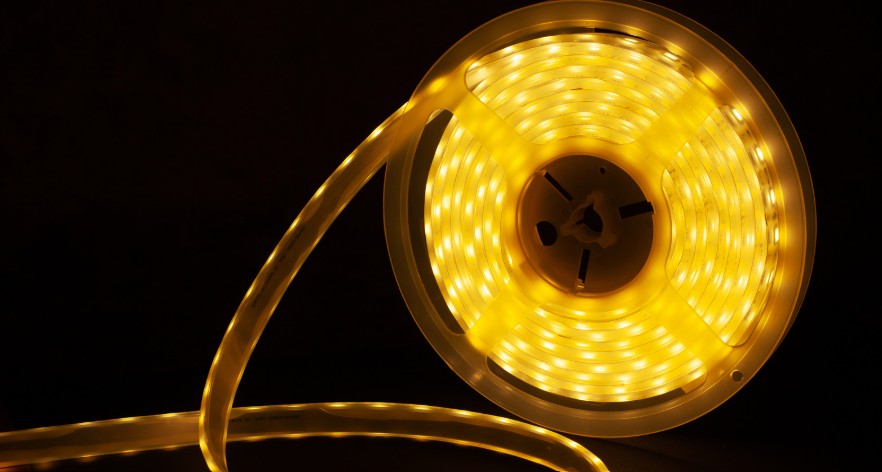LED strip lights have revolutionized the lighting industry with their energy efficiency, versatility, and modern design appeal. Whether you are decorating your home, upgrading commercial spaces, or adding accent lighting to your car, LED strip lights are a top choice for both aesthetics and functionality. In this guide, we will explore the benefits, applications, and tips for choosing the best LED strip lights for your needs.
What Are LED Strip Lights?
LED strip lights, also known as LED tape lights or ribbon lights, are flexible circuit boards embedded with light-emitting diodes (LEDs). They come with an adhesive backing, making them easy to install on almost any surface. LED strip lights are available in various lengths, colors, and brightness levels, giving users complete customization for their lighting projects.
Benefits of LED Strip Lights

1. Energy Efficiency
One of the biggest advantages of LED strip lights is their low energy consumption. Compared to traditional incandescent bulbs, LED strip lights use up to 80% less energy while producing the same or even brighter illumination.
2. Long Lifespan
High-quality LED strip lights can last up to 50,000 hours, making them a cost-effective lighting solution that requires minimal maintenance or replacements.
3. Versatile Design
LED strip lights are flexible, cuttable, and available in waterproof options. You can bend them around corners, trim them to fit specific lengths, or even use them outdoors.
4. Variety of Colors and Effects
From warm white for cozy home décor to RGB or RGBIC lights for colorful effects, LED strip lights offer endless possibilities. Many come with smart controls, allowing users to change colors, adjust brightness, or sync the lights with music.
5. Easy Installation
Most LED strip lights come with a peel-and-stick adhesive backing, making installation simple and quick. Some even have plug-and-play options, eliminating the need for professional electricians.
Popular Applications of LED Strip Lights
1. Home Decoration
- Living Rooms: Install LED strip lights behind TVs, under sofas, or along ceilings to create an ambient glow.
- Kitchens: Place them under cabinets or along countertops for better visibility and modern style.
- Bedrooms: Soft LED strip lighting under the bed or around mirrors adds a relaxing atmosphere.
2. Commercial Spaces
Retail stores, restaurants, and hotels use LED strip lights for accent lighting, product displays, and creating inviting environments for customers.
3. Outdoor Lighting
Waterproof LED strip lights are perfect for patios, decks, gardens, and pool areas. They enhance safety while providing stylish illumination.
4. Automotive Lighting
Car enthusiasts often use LED strip lights for under-glow effects, interior car lighting, or trunk illumination.
5. Events and Parties
LED strip lights are a favorite for weddings, parties, and holiday decorations. With color-changing options, they can easily match any theme or mood.
How to Choose the Best LED Strip Lights?

When shopping for LED strip lights, consider the following factors:
1. Brightness and Color Temperature
Brightness is measured in lumens, and color temperature is measured in Kelvin (K).
- Warm white (2700K–3000K): Cozy and relaxing atmosphere.
- Cool white (5000K–6500K): Bright and energetic, suitable for workspaces.
- RGB or RGBIC: Multicolor lights for decorative effects.
2. Power Supply and Voltage
Ensure you buy the right power adapter for your LED strip lights. Common voltages are 12V and 24V. A reliable led power supply ensures optimal brightness and extends the lifespan of the lights.
3. Waterproof Rating
If you plan to install LED strip lights outdoors or in humid areas (like bathrooms), choose waterproof models with an IP65 or higher rating.
4. Smart Features
Many modern LED strip lights are compatible with smart home systems like Alexa or Google Assistant. Features such as remote control, smartphone apps, and music-sync modes enhance convenience and fun.
5. Length and Cuttable Design
Measure the installation area before purchasing. Look for cuttable and extendable LED strip lights for a perfect fit.
6. Quality and Brand Reputation
Choose reputable brands or suppliers to ensure high-quality LEDs, safe power adapters, and long-lasting performance.
Installation Tips for LED Strip Lights
- Clean the Surface: Ensure the surface is dry and dust-free for proper adhesion.
- Measure Before Cutting: Cut only at designated points to avoid damaging the circuit.
- Use Clips or Channels: For better heat dissipation and a professional look, use mounting clips or aluminum channels.
- Connect Properly: Follow wiring instructions carefully, especially for RGB and smart LED strip lights.
- Test Before Final Installation: Plug in and test the lights before securing them permanently.
Why LED Strip Lights Are the Future of Lighting?
The growing demand for energy-efficient and customizable lighting makes LED strip lights an essential part of modern lighting solutions. With innovations such as smart home integration and advanced RGB effects, LED strip lights are not just functional, they also enhance ambiance, creativity, and lifestyle.
Conclusion
Whether you are upgrading your home, enhancing your business, or adding stylish effects to your car, LED strip lights offer an affordable, energy-efficient, and versatile lighting solution. By choosing high-quality products and installing them correctly, you can enjoy years of stunning illumination.
If you are searching for the best LED strip lights, consider factors like brightness, color temperature, waterproofing, and smart features. With the right choice, you can transform any space into a beautifully lit environment.
Author Profile

- Blogger by Passion | Contributor to many Business Blogs in the United Kingdom | Fascinated to Write Blogs in Business & Startup Niches |
Latest entries
 Real EstateJuly 23, 2025How Tenant in Situ Sales Affect Property Value?
Real EstateJuly 23, 2025How Tenant in Situ Sales Affect Property Value? BusinessJuly 21, 2025The Ultimate Guide to LED Strip Lights: Benefits, Applications, and Buying Tips
BusinessJuly 21, 2025The Ultimate Guide to LED Strip Lights: Benefits, Applications, and Buying Tips Home & LivingJuly 12, 2025Shared Planning for a Stronger Future
Home & LivingJuly 12, 2025Shared Planning for a Stronger Future BusinessJuly 4, 2025How To Build an Integrated Development Plan That Works?
BusinessJuly 4, 2025How To Build an Integrated Development Plan That Works?





